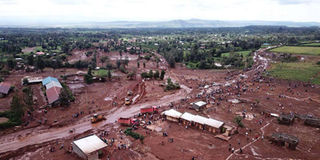Patel Dam tragedy: Rhetoric and reality

An Ariel view of the damage Energy village in Solai, Nakuru County, suffered after Patel Dam collapsed killing 45 people on May 10, 2018. Chief Administrative Secretary in the Ministry of Interior Patrick ole Ntutu said the ministry was not aware of the compensation process to the victims by the dam owners. PHOTO | NATION MEDIA GROUP
A dam which collapsed last week in Solai, Nakuru County left 45 people dead and hundreds homeless.
Immediately after the tragedy, Water and Irrigation Secretary Simon Chelugui said all dams will be inspected to ensure they do not endanger lives.
PATEL DAM
Mr Chelugui said, "We will dispatch experts and engineers to inspect materials used, whether they were built on water ways, and if the engineers who oversaw their construction were licensed. We do not want another tragedy.”
Mr Chelugui who spoke when he toured the killer Patel Dam was accompanied by Nakuru Governor Lee Kinyanjui.
Mr Kinyanjui welcomed the inspection of all other dams in the region to avert another tragedy.
The utterances of the two officials stirred reaction among Kenyans online who decried the common practice by government officials to only act after a crisis happens.
Dr Nancy Booker, faculty at the Aga Khan University Graduate School of Media and Communications, took to Facebook to comment on the issue.
She posted: “So what we are saying is, a crisis must happen for someone to do their job. Haven’t we learnt from our past? Who bewitched us? Honestly who did? It is cliché. It is tiring. It is annoying. It is sickening…A building collapses, lives are lost. All buildings to undergo inspection. A road accident happens... lives are lost ...all vehicles to undergo inspection. Let me stop here before I type what’s going through my mind right now. I shudder trying to visualize what these families in Solai went through on that fateful evening”.
Judy Thuo wrote: "Whoever bewitched Kenyans died. A few months after the floods we will be going through another disaster phase, drought.’
Ben Owen expressed his disgust: "Africa is literally cursed. Everything is upside down. We rarely get it right in every aspect. Perhaps we only get it right at making contributions for the bereaved or victims."
Hollie Mollie said: Then after the inspection we go back to our old ways of doing things without implementing the standards. When will things ever work? When will we move forward? When will we ever work towards seeing our country truly develop?"
The dam, built within a coffee farm, released over 70 million litres of water when it collapsed on Wednesday night, washing away an entire village.
DISASTERS
The criticism over government’s promise to ‘inspect and implement’ measures to avert disaster by Kenyans could be well-founded considering that three years after the collapse of the seven-storey building in Huruma on January 4, 2015 president Uhuru Kenyatta ordered an audit report of all buildings in Nairobi and in
May 2016, the president again raised issue that the audit report continued to gather dust as its recommendations were yet to be implemented by City Hall and National Construction Authority. The president made the statement in the wake of the collapse of yet another building in Huruma following a heavy downpour. The audit had already identified houses which were not structurally sound in most parts of Eastlands, Dagoretti, Kasarani, Zimmerman, Roysambu, Githurai 44 and 45, Garden Estate, Thome, and Kilimani.
In March 2018, Governor Mike Sonko said that an audit on buildings conducted by the Nairobi City Inspectorate Department revealed that several buildings, among them 688 structures needed urgent inspection. The audit which was conducted between January and February showed that only 884 structures are considered safe for habitation, and some 471 houses are unfit for occupancy and warrant critical inspection.
The report indicated that some 217 buildings need to be demolished immediately as they have been marked dangerous for habitation. It is still not clear as to how far the demolitions and inspections have been done. The rise in buildings collapsing has been blamed on the ongoing heavy rains.
A list of collapsed buildings in recent years
March 2018: A five-storey building under construction collapsed in Juja, Kiambu County. Barely 48 hours after that incident, another building collapsed in Ruai Estate near the Eastern Bypass.
March 2018: A building collapsed in Kariobangi. All residents who lived in the four-storey building were evacuated before the collapse and no casualties were reported.
January 2018: Two people died when a building they were demolishing at Stage Mpya in Pipeline Estate collapsed. Seven other people were injured.
April 28, 2016: A wall collapsed along Nairobi’s Lenana Road. Three people died and several others injured.
March 09, 2016: A four-storey building in Zimmerman, Nairobi, whose construction was questioned two years before collapsed. No one was injured since it had been vacated.
May 11, 2015: A perimeter wall at a South B mosque collapsed due to heavy rains. 10 people died.
April 2, 2015: Seven people died and many others trapped after a building behind Thika Road Mall in Roysambu collapsed.
Jan 4, 2015: Five people died and several others injured after a six-storey residential building collapsed in Huruma estate.
December 17, 2014: A five-storey residential building that was partly occupied and was still under construction collapsed in Kaloleni. Seven people died.
January 10, 2010: A building in Kiambu town collapsed due to heavy rains. Three people died.
June 9, 2012: Three people died after a building under construction collapsed in Mlolongo.
September 17, 2011: Four died after a three-storey building collapsed in heavy rainfall at Mabona area of Lwanda trading centre in Emuhaya, Vihiga County.
June 14, 2011: Two workers died after a six-storey building under construction collapsed in Nairobi
January 2006: A five- storey building under construction along Ronald Ngala Street collapsed. 14 people died and 14 more injured.





